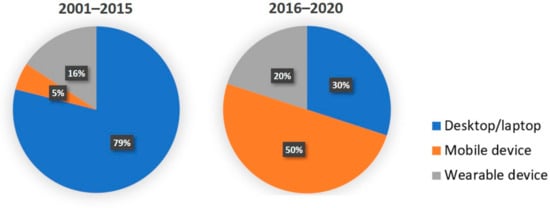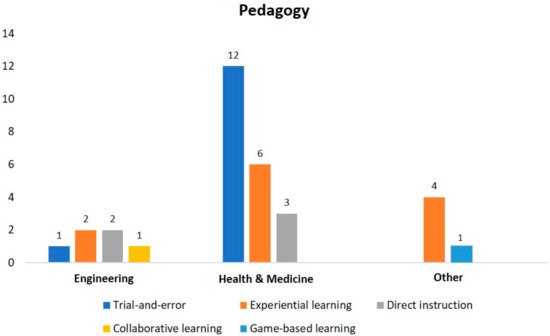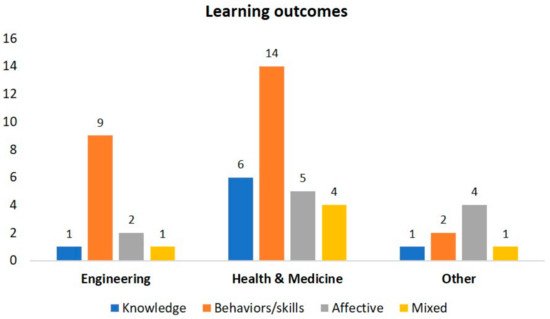
Video Upload Options
Professional training is defined as a set of behaviors and acts with the purpose of increasing the employees’ professional skills to carry out a particular job in a better manner. Such a definition highlights three important features of professional training. First, its purpose is educational, which focuses on employee development (e.g., skill acquisition and knowledge growth) rather than performance improvement.
Augmented reality (AR) is defined as a technology-enhanced environment where virtual objects (augmented components) can be overlaid into the real world. Azuma (1997) identified three technical features of AR: a combination of the real and virtual world, real-time interaction, and accurate 3D registration of virtual and real objects.
1. Introduction
2. Computing Devices

3. Media Representation
| Symbol/ Indicator |
Text | Data | 2D Image | 3D Object | Video | Animation | Mixed | Total | |
|---|---|---|---|---|---|---|---|---|---|
| >Engineering | 1 | 4 | 0 | 3 | 8 | 5 | 4 | 4 | 29 |
| Health and medicine | 2 | 3 | 3 | 4 | 16 | 6 | 2 | 8 | 44 |
| Other | 1 | 4 | 0 | 2 | 3 | 1 | 0 | 4 | 15 |
| Total | 4 | 11 | 3 | 9 | 27 | 12 | 6 | 16 | 88 |
4. Instructional Design
4.1. Pedagogy

4.2. Types of Learning Outcomes

4.3. Instructional Function and Interactivity

References
- Anderson, K. Education and training for records professionals. Rec. Manag. J. 2007, 17, 94–106.
- Cheng, E.W.L.; Ho, D.C.K. The influence of job and career attitudes on learning motivation and transfer. Career Dev. Int. 2001, 6, 20–27.
- Paposa, K.K.; Kumar, Y.M. Impact of training and development practices on job satisfaction: A study on faculty members of technical education institutes. Manag. Labour Stud. 2019, 44, 1–15.
- Truiit, D.L. The effect of training and development on employee attitude as it relates to training and Work Proficiency. SAGE Open 2011, 1, 1–13.
- Bower, M.; Howe, C.; McCredie, N.; Robinson, A.; Grover, D. Augmented reality in education—Cases, places and potentials. Educ. Media Int. 2014, 51, 1–15.
- Abhari, K.; Baxter, J.S.H.; Chen, E.C.S.; Khan, A.R.; Petters, T.M.; de Ribaupierre, S.; Eagleson, R. Training for planning tumour resection: Augmented reality and human factors. IEEE Trans. Biomed. Eng. 2015, 62, 1466–1477.
- Lee, D.Y.; Shin, D.H. An empirical evaluation of multi-media based learning of a procedural task. Comput. Hum. Behav. 2012, 28, 1072–1081.
- Han, X.; Liu, Y.; Li, H.; Fan, Z.; Luo, H. Augmenting the makerspace: Designing collaborative inquiry through augmented reality. In Proceedings of the 2020 International Conference on Blended Learning, Bangkok, Thailand, 24–27 August 2020; Cheung, S., Li, R., Phusavat, K., Paoprasert, N., Kwok, L., Eds.; Springer: Cham, Switzerland, 2020; Volume 12218, pp. 148–159.
- Phan, V.T.; Choo, S.Y. Developing outdoor augmented reality for architecture representation in educational activities. Int. J. Des. Sci. Technol. 2010, 17, 121–136.
- Moro, C.; Stromberga, Z.; Raikos, A.; Stirling, A. The effectiveness of virtual and augmented reality in health sciences and medical anatomy. Anat. Sci. Educ. 2017, 10, 549–559.
- Juan, M.-C.; Alexandrescu, L.; Folguera, F.; García-García, I. A mobile augmented reality system for the learning of dental morphology. Digit. Educ. Rev. 2016, 30, 234–247.
- Leblanc, F.; Senagore, A.J.; Ellis, C.N.; Champagne, B.J.; Augestad, K.M.; Neary, P.C.; Delaney, C.P.; Colorectal Surgery Training Group. Hand-Assisted laparoscopic sigmoid colectomy skills acquisition: Augmented reality simulator versus human cadaver training models. J. Surg. Educ. 2010, 67, 200–204.
- Arts, E.E.A.; Leijte, E.; Witteman, B.P.L.; Jakimowicz, J.J.; Verhoeven, B.; Botden, S.M.B.I. Face, content, and construct validity of the Take-Home EoSim augmented reality laparoscopy simulator for basic laparoscopic tasks. J. Laparoendosc. Adv. Surg. Tech. 2019, 29, 1419–1426.
- Indrawan, I.W.A.; Bayupati, I.P.A.; Putri, D.P.S. Markerless augmented reality utilizing gyroscope to demonstrate the position of Dewata Nawa Sanga. Int. J. Interact. Mob. Technol. 2018, 12, 19–35.
- Chin, K.Y.; Lee, K.F.; Hsieh, H.C. Development of a mobile augmented reality system to facilitate real-world learning. In Frontier Computing; Hung, J., Yen, N., Li, K.C., Eds.; Springer: Singapore, 2016; Volume 375, pp. 363–372.
- Lester, S.; Hofmann, J. Some pedagogical observations on using augmented reality in a vocational practicum. Br. J. Educ. Technol. 2020, 51, 645–656.
- Feifer, A.; Delisle, J.; Anidjar, M. Hybrid augmented reality simulator: Preliminary construct validation of laparoscopic smoothness in a urology residency program. J. Urol. 2008, 180, 1455–1459.
- Maas, M.J.; Hughes, J.M. Virtual, augmented and mixed reality in K–12 education: A review of the literature. Technol. Pedagog. Educ. 2020, 29, 231–249.
- Frazen, M.M.S. A Study of Trial and Error Learning in Technology, Engineering, and Design Education. Ph.D. Thesis, North Carolina State University, Raleigh, NC, USA, 2016.
- Bourdel, N.; Collins, T.; Pizarro, D.; Bartoli, A.; Ines, D.D.; Perreira, B.; Canis, M. Augmented reality in gynecologic surgery: Evaluation of potential benefits for myomectomy in an experimental uterine model. Surg. Endosc. 2016, 31, 456–461.
- Huang, C.Y.; Thomas, J.B.; Alismail, A.; Cohen, A.; Almutairi, W.; Daher, N.S.; Terry, M.H.; Tan, L.D. The use of augmented reality glasses in central line simulation: “See one, simulate many, do one competently, and teach everyone”. Adv. Med. Educ. Pract. 2018, 9, 357–363.
- Kolb, D.A. Experiential Learning: Experience as the Source of Learning and Development; Prentice-Hall: Hoboken, NJ, USA, 1984; p. 41.
- Upadhyay, A.K.; Khandelwal, K. In the age of e-learning: Application and impact of augmented reality in training. Dev. Learn. Organ. Int. J. 2018, 26, 42–45.
- Reyes, A.M.; Villegas, O.O.V.; Bojorouez, E.M.; Sanchez, V.G.C.; Nandayapa, M. A Mobile Augmented reality system to support machinery operations in scholar environments. Comput. Appl. Eng. Educ. 2016, 24, 967–981.
- Watanuki, K.; Hou, L. Augmented reality-based training system for metal casting. J. Mech. Sci. Technol. 2010, 24, 237–240.
- Chimienti, V.; Iliano, S.; Dassisti, M.; Dini, G.; Failli, F. Guidelines for implementing augmented reality procedures in assisting assembly operations. In Proceedings of the Precision Assembly Technologies and Systems, 5th IFIP WG 5.5 International Precision Assembly Seminar, IPAS 2010, Chamonix, France, 14–17 February 2010; Ratchev, S., Ed.; Springer: Berlin/Heidelberg, Germany, 2010; Volume 315, pp. 174–179.
- Zhang, J.; Ong, S.K.; Nee, A.Y.C. A multi-regional computation scheme in an AR-assisted in situ CNC simulation environment. Comput.-Aided Des. 2010, 42, 1167–1177.
- Anastassova, M.; Burkhardt, J.-M. Automotive technicians’ training as a community-of-practice: Implications for the design of an augmented reality teaching aid. Appl. Ergon. 2009, 40, 713–721.
- Botden, S.M.B.I.; de Hingh, I.H.J.T.; Jakimowicz, J.J. Suturing training in augmented reality: Gaining proficiency in suturing skills faster. Surg. Endosc. 2009, 23, 2131–2137.
- Cubillo, J.; Martin, S.; Castro, M.; Boticki, I. Preparing augmented reality learning content should be Easy: UNED ARLE—An authoring tool for augmented reality learning environments. Comput. Appl. Eng. Educ. 2015, 23, 778–789.
- Coelho, G.; Rabelo, N.N.; Vieira, E.; Mendes, K.; Figueiredo, E.G. Augmented reality and physical hybrid model simulation for preoperative planning of metopic craniosynostosis surgery. Neurosurg. Focus 2020, 48, E19.
- Sirakaya, M.; Cakmak, E.K. Effects of augmented reality on student achievement and Self-Efficacy in vocational education and training. Int. J. Res. Vocat. Educ. Train. 2018, 5, 1–18.
- Bacca Acosta, J.L.; Navarro, S.B.; Gesa, R.F.; Kinshuk. Insights into the factors influencing student motivation in augmented reality learning experiences in vocational education and training. Front. Psychol. 2018, 9, 1486.
- Ingrassia, P.L.; Mormando, G.; Giudici, E.; Strada, F.; Carfagna, F.; Lamberti, F.; Bottino, A. Augmented Reality Learning Environment for Basic Life Support and Defibrillation Training: Usability Study. J. Med. Internet Res. 2020, 22, e14910.
- Díaz-Noguera, M.D.; Toledo-Morales, P.; Hervás-Gómez, C. Augmented reality applications attitude Scale (ARAAS): Diagnosing the attitudes of future teachers. New Educ. Rev. 2018, 50, 215–226.
- Alismail, A.; Thomas, J.; Daher, N.S.; Cohen, A.; Almutairi, W.; Terry, M.H.; Huang, C.; Tan, L.D. Augmented reality glasses improve adherence to evidence-based intubation practice. Adv. Med. Educ. Pract. 2019, 10, 279–286.
- Rochlen, L.R.; Levine, R.; Tait, A.R. First-person point-of-view–augmented reality for central line insertion training. Simul. Healthc. J. Soc. Simul. Healthc. 2017, 12, 57–62.
- Xiao, J.; Cao, M.; Li, X.; Hansen, P. Assessing the effectiveness of the augmented reality courseware for starry sky exploration. Int. J. Distance. Educ. Technol. 2020, 18, 19–35.




